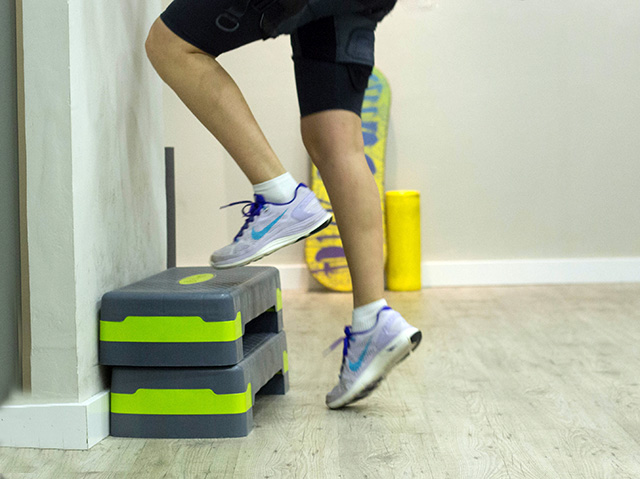This page describes the procedure for conducting the YMCA version of a step test. A similar test is theQueens College step test, though it has a higher step and a different stepping rate for men and women. See the other variations of step tests.
test purpose: a step test provides a submaximal measure of cardio-respiratory or endurance fitness (see also other step tests)
equipment required: 12 inch (30 cm) step, stopwatch, metronome or cadence tape, stethoscope.
pre-test: Explain the test procedures to the subject. Perform screening of health risks and obtain informed consent. Prepare forms and record basic information such as age, height, body weight, gender, test conditions. Check step height and set metronome. See more details of pre-test procedures.
 step-up testing
step-up testingprocedure: Begin by demonstrating the alternating stepping cadence to the subject. In time with the beat step one foot up on the bench (1st beat), step up with the second foot (2nd beat), step down with one foot (3rd beat), and step down with the other foot (4th beat.) Allow the subject to practice the stepping to the metronome cadence, which is set at 96 beats per minute (4 clicks = one step cycle) for a stepping rate of 24 steps per minute. The athlete steps up and down on the platform at the given rate for a total of 3 minutes. The athlete immediately stops on completion of the test and sits down and remains still. Starting within 5 seconds, the tester is to count the participant's heart rate (ideally with a stethoscope) for one complete minute.
scoring: The total one-minute post-exercise heart rate is the participant's score for the test.
advantages: all step tests require minimal equipment and costs, and if required the test can be self-administered.
disadvantages: As the step is the same size for all people (men and women), biomechanical characteristics such as height and lower limb length may give an advantage.
Similar Tests
- There is a similar 3 minute step test: Queen's College Step Test
- YMCA Cycle ergometer submaximal test
Related Pages
- About the YMCA Fitness Test
- General Step Test procedure, and other step tests.
- About a Step Test iphone app
- Video of Step tests being performed.
- Step up exercises at the beach or during pregnancy
- More information on measuring heart rate



